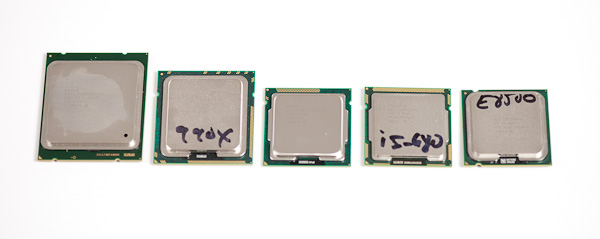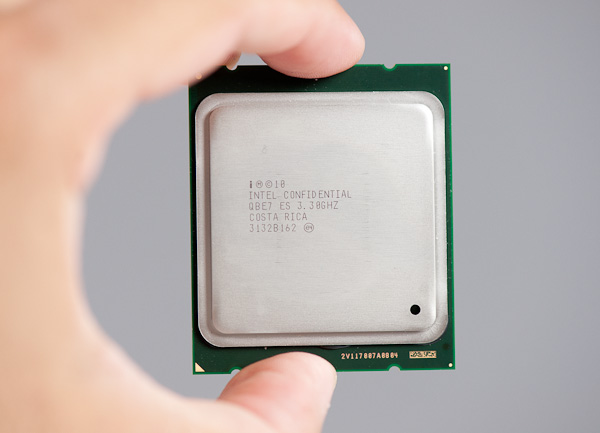Intel Core i7 3960X (Sandy Bridge E) Review: Keeping the High End Alive
by Anand Lal Shimpi on November 14, 2011 3:01 AM EST- Posted in
- CPUs
- Intel
- Core i7
- Sandy Bridge
- Sandy Bridge E
Final Words
There are two aspects of today's launch that bother me: the lack of Quick Sync and the chipset. The former is easy to understand. Sandy Bridge E is supposed to be a no-compromise, ultra high-end desktop solution. The lack of an on-die GPU with Quick Sync support means you have to inherently compromise in adopting the platform. I'm not sure what sort of a solution Intel could've come to (I wouldn't want to give up a pair of cores for a GPU+QuickSync) but I don't like performance/functionality tradeoffs with this class of product. Secondly, while I'm not a SAS user, I would've at least appreciated some more 6Gbps SATA ports on the chipset. Native USB 3.0 support would've been nice as well. Instead what we got was effectively a 6-series chipset with a new name. As Intel's flagship chipset, the X79 falls short.

From left to right: Intel Core i7 (SNB-E), Core i7 (Gulftown), Core i5 (SNB), Core i5 (Clarkdale), Core 2 Duo
LGA-2011, 1366, 1155, 1156, 775
The vast majority of desktop users, even enthusiast-class users, will likely have no need for Sandy Bridge E. The Core i7 3960X may be the world's fastest desktop CPU, but it really requires a heavily threaded workload to prove it. What the 3960X doesn't do is make your gaming experience any better or speed up the majority of desktop applications. The 3960X won't be any slower than the fastest Sandy Bridge CPUs, but it won't be tremendously faster either. The desktop market is clearly well served by Intel's LGA-1155 platform (and its lineage); LGA-2011 is simply a platform for users who need a true powerhouse.
There are no surprises there, we came to the same conclusion when we reviewed Intel's first 6-core CPU last year. If you do happen to have a heavily threaded workload that needs the absolute best performance, the Core i7 3960X can deliver. In our most thread heavy tests the 3960X had no problems outpacing the Core i7 2600K by over 50%. If your livelihood depends on it, the 3960X is worth its entry fee. I suspect for those same workloads, the 3930K will be a good balance of price/performance despite having a smaller L3 cache. I'm not terribly interested in next year's Core i7 3820. Its point is obviously for those users who need the memory bandwidth or PCIe lanes of SNB-E, but don't need more than four cores. I would've liked to have seen a value 6-core offering instead, but I guess with a 435mm2 die size it's a tough sell for Intel management.
Of course compute isn't the only advantage of the Sandy Bridge E platform. With eight DIMM slots on most high end LGA-2011 motherboards you'll be able to throw tons of memory at your system if you need it without having to shop for workstation motherboards with fewer frills.
As for the future of the platform, Intel has already begun talking about Ivy Bridge E. If it follows the pattern set for Ivy Bridge on LGA-1155, IVB-E should be a drop in replacement for LGA-2011 motherboards. The biggest issue there is timing. Ivy will arrive for the mainstream LGA-1155 platforms around the middle of 2012. At earliest, I don't know that we'd see it for LGA-2011 until the end of next year, or perhaps even early 2013 given the late launch of SNB-E. This seems to be the long-term downside to these ultra high-end desktop platforms these days: you end up on a delayed release cadence for each tick/tock on the roadmap. If you've always got to have the latest and greatest, this may prove to be frustrating. Based on what we know of Ivy Bridge however, I suspect that if you're using all six of these cores in SNB-E that you'll wish you had IVB-E sooner, but won't be tempted away from the platform by a quad-core Ivy Bridge on LGA-1155.
I do worry about the long term viability of the ultra high-end desktop platform. As we showed here, some of the gains in threaded apps exceed 50% over a standard Sandy Bridge. That's tangible performance to those who can use it. With the growth in cloud computing it's clear there's demand for these types of chips in servers. I just hope Intel continues to offer a version for desktop users as well.











163 Comments
View All Comments
JlHADJOE - Tuesday, November 15, 2011 - link
On Page 2, 'The Pros and Cons':> Intel's current RST (Rapid Story Technology) drivers don't support X79,
Rapid Storage, perhaps?
jmelgaard - Tuesday, November 15, 2011 - link
Computers are only getting faster one way today, and that is more cores, designing for up to a strict number of cores is merely stupidity in today's world.That said, developing games that support multiple cores might be somewhat more difficult than designing highly concurrent applications that processes data or request for data. (I can't say for sure as I have only briefly touched the game development part of the industry, but I work with the other part on a daily basis)
But while you might save development cost right now going down that road, you will spent the savings ones you suddenly have to think 8 cores in.
Carrying technical debt is never a good thing (And designing with a set number of cores in mind can to my programming experience only add that), it will only get more expensive to remove down the road, that has been proven to be true again and again.
And that is even considering that Frostbite 3 might be developed from the ground up, they still have to think up the concept again, while had they gone for high concurrency, then that concept would already be in place for the next version.
TC2 - Tuesday, November 15, 2011 - link
note,BD 4x2bc ~ 2B elements, 315mm2
SB-E 6x2hc ~ 2.27B elements ~ +14%, 435mm2 ~ +38% (includes unused space for 2 more cores), up to 15MB cache, ...
impressive at all!
C300fans - Tuesday, November 15, 2011 - link
Intel Gulftown 6C 32nm 6 1.17B 240mm2Intel Sandy Bridge E (6C) 32nm 6 2.27B 435mm2
I dont see any impressive thing. any performance improves?
Blaster1618 - Tuesday, November 15, 2011 - link
Given QPI @ 3.2 Ghz 205 Gb/s (25.6 GB/s) also handled the PCI load, can't we have something in the middle. I'm still a little confused is DMI 2.0 still just mainly simple parallel interface where QPI is a high speed series interface?C300fans - Tuesday, November 15, 2011 - link
Just imagine DMI 1.0 is a 4pcs pci-e 1x 1.0.DMI 2.0 is a 4pcs pci-e 1x 2.0
jmelgaard - Tuesday, November 15, 2011 - link
Clearly you didn't read a single of my points, or simply lack the understanding.Applications are not developed to target specific cores, you OS handles all that, it is a simple matter of pushing out jobs in threads or processes.
Processing in 10, 100 or 1000 threads/processes is no more difficult than doing it in 4... it just requires you have enough "JOBS" to process (and that term was deliberately chosen)...
This requires a different mindset though, and this might be more difficult to think of games that way right now, mostly because they have been use to running everything in that single game loop, but doing it now could be a rather good ROI down the road.
DarkUltra - Tuesday, November 15, 2011 - link
How about overclocking with turbo boost enabled? I mean, if the 3960X is stable at 4.4GHz, can it be stable at 4.8GHz when games or applications only use four cores? Then it would overclock and perform as good as a 2600K with four heavy threads.yankeeDDL - Tuesday, November 15, 2011 - link
Guys, there are always people with more money than brain that will purchase just about anything.That's not the point. Having the fastest CPU makes it a status symbol and whoever makes it can have the luxury to price it in the $1000 range, for fools to buy.
I don't know about CPUs, but I do know that the top performing GPUs (HD6990 and GTX590) are sold in extremely low volumes, both because of the relatively low ROI, both because the market is so little that inventory are scarce to begin with.
So, you may be right on the CPU side, but in general, you're both wrong.
This said, my point was that if AMD had performed and delivered a good CPU, instead of the FX8150, OR, the FX8150 at a good price point ($170, not $279), then Intel would have had a tougher time in pushing out the 3960X for this price, AND, it would have had to work harder on the chipset. However, because of the huge lead it has over AMD, Intel now can comfortably rebrand a "mid range" chipset and shove it to the customer who has no choice but take it if they want the best CPU.
retoureddy - Wednesday, November 16, 2011 - link
I agree on the fact that only 2 6GB SATA ports are a disappointment. Interesting though is to run two SSD in RAID 0 on the intel controller. With two Kingston SSD I manage real good figures (Crystal Disk Mark) : 4000MB test -> 1040MB/s Read and 621MB/s Write in (SEQ) / 675 and 481 (512K) / 28 and 253 (4K) / 279 and 405 4K QD32. I never managed this kind of throughput on the Z68 or P67 on-board controllers. These numbers are getting close to hardware RAID controllers like ARECA and LSI. I would have been interested to see where the bottleneck lies if X79 would have had more ports. Even though X58 is 3GB Sata you had no problem bottle-necking the Intel RAID controller at around 800MB/s.